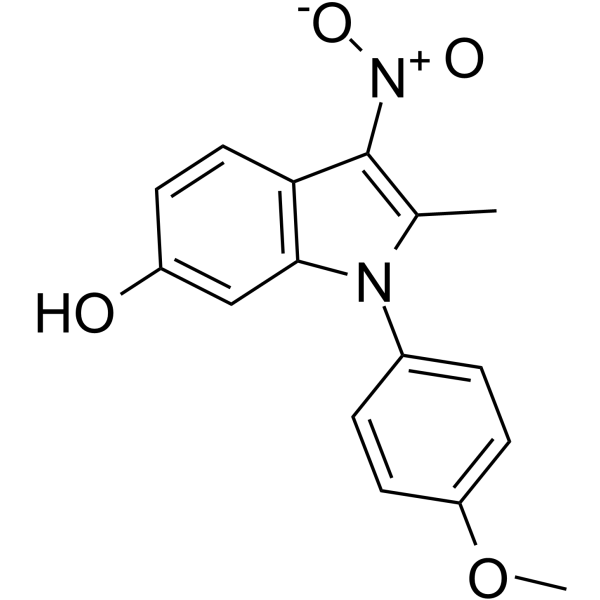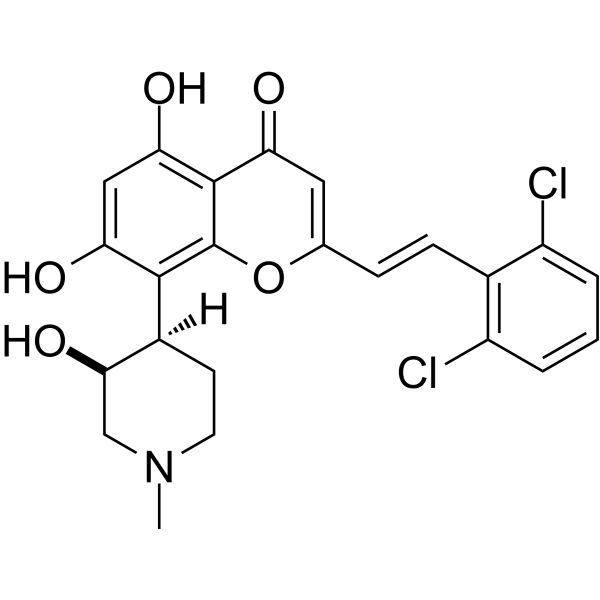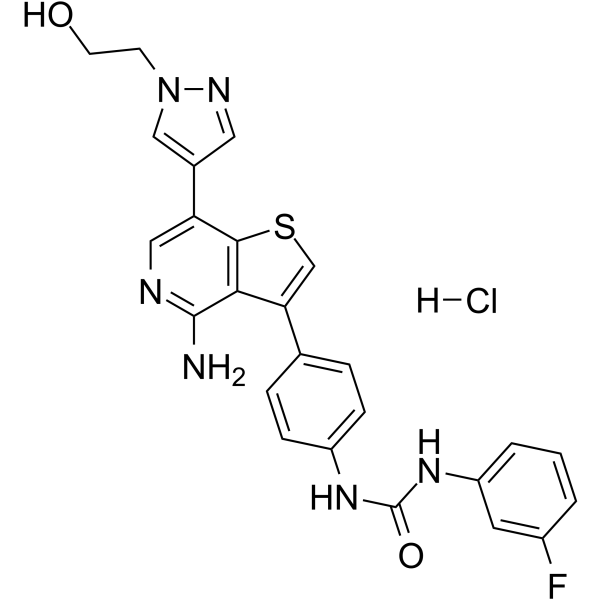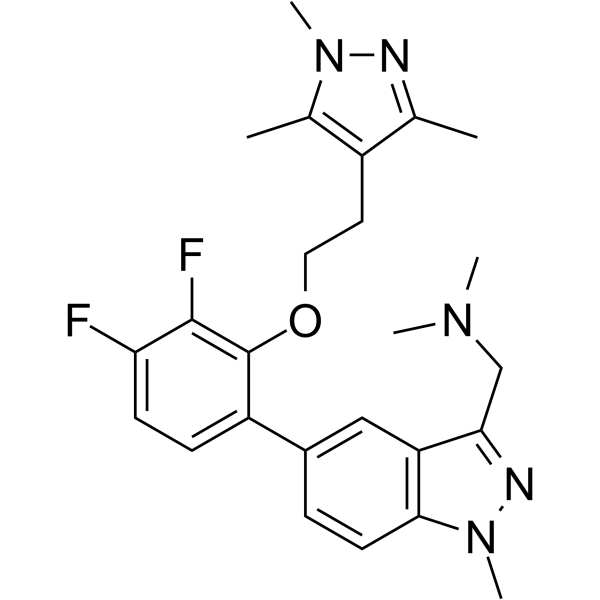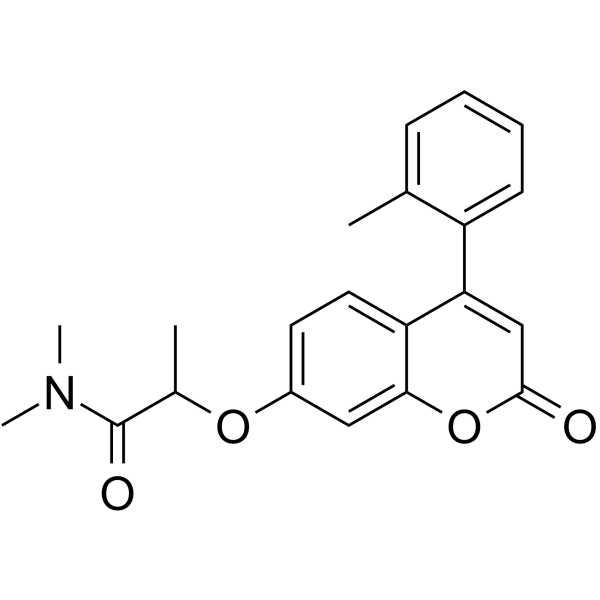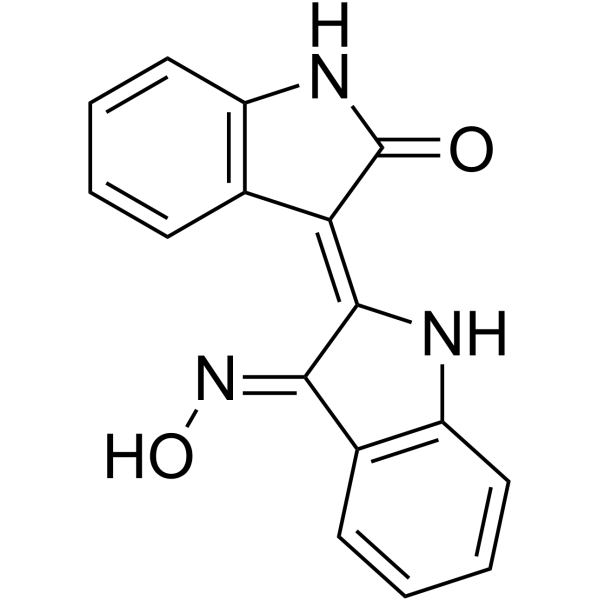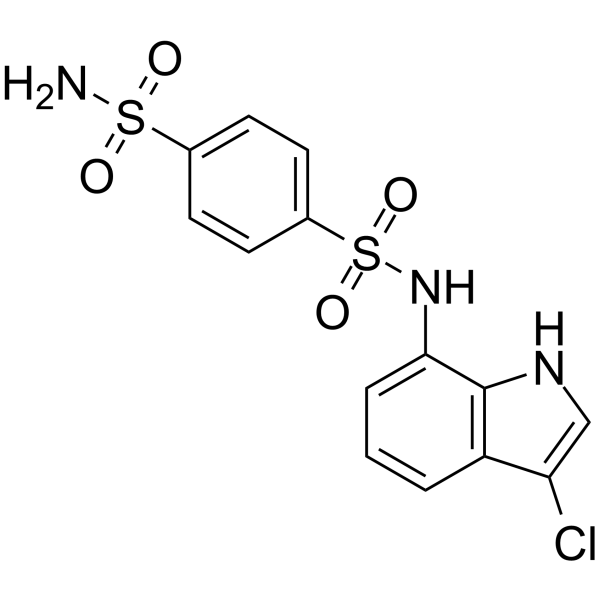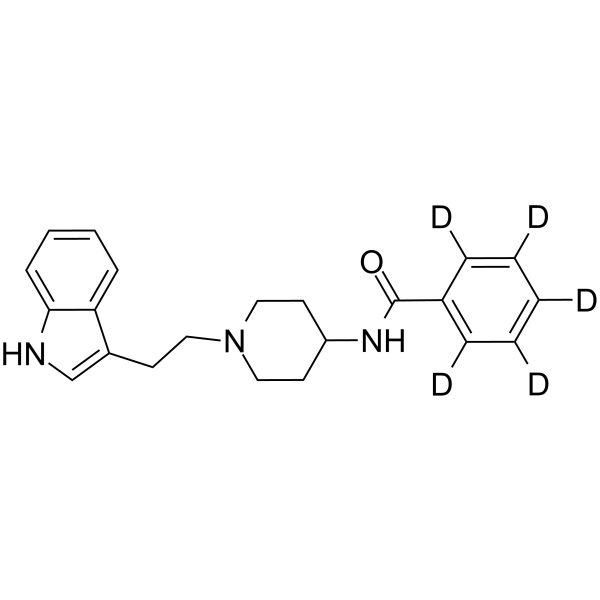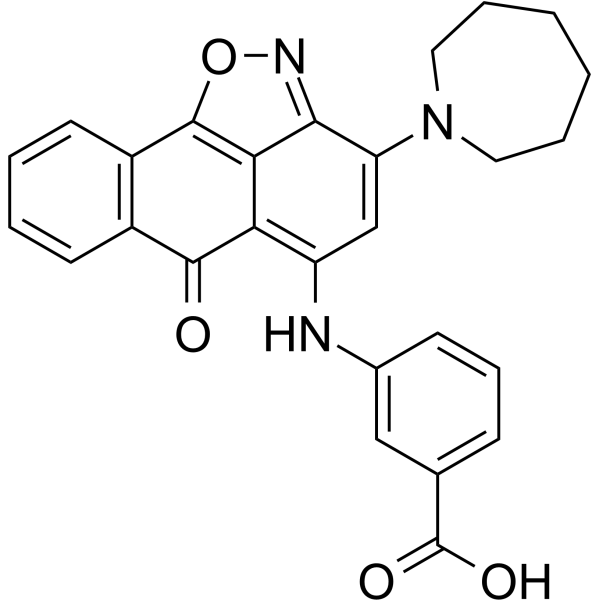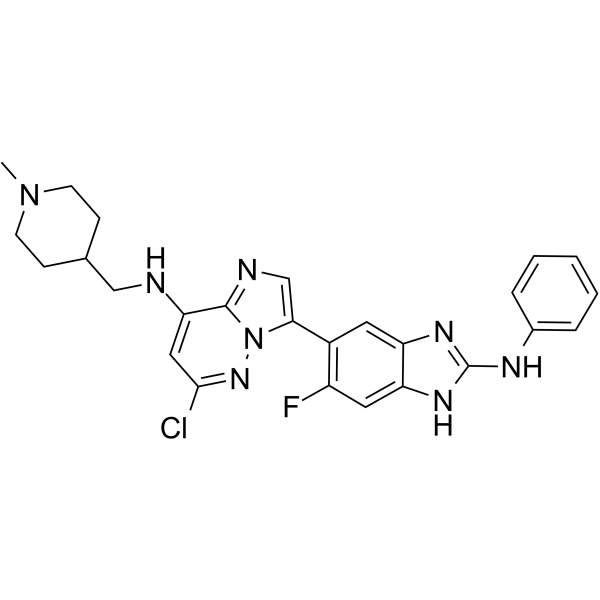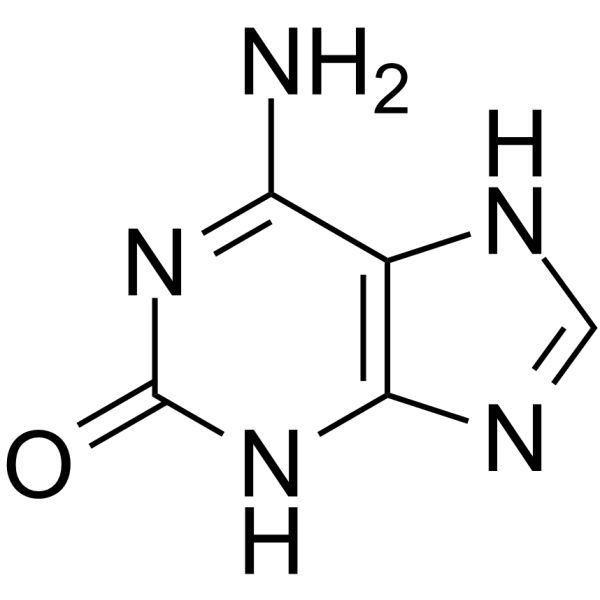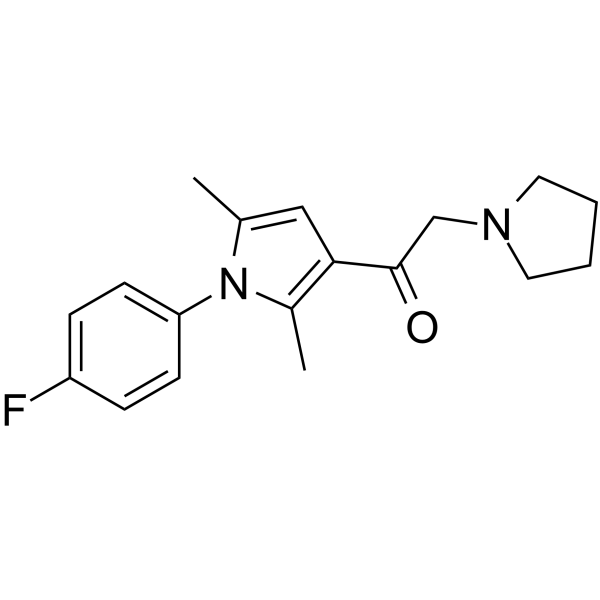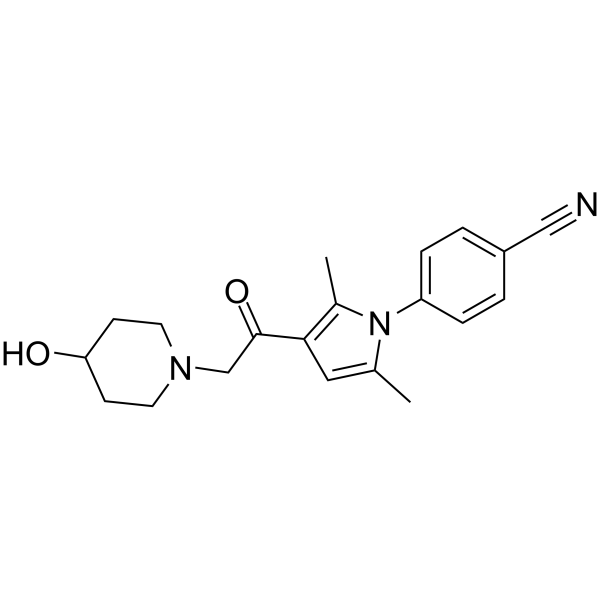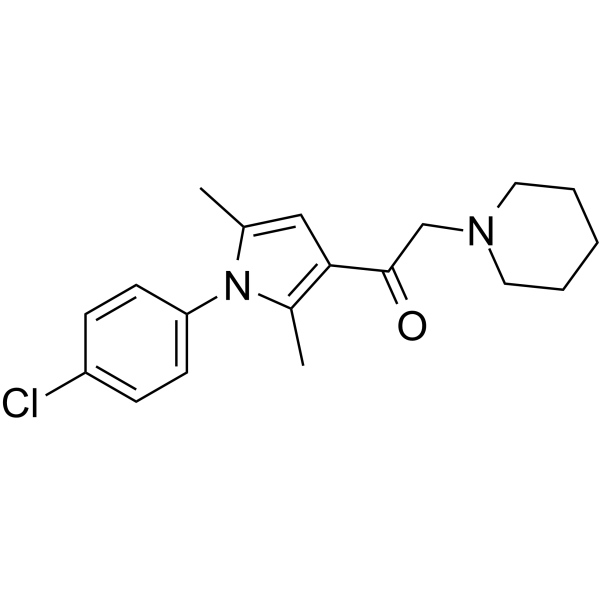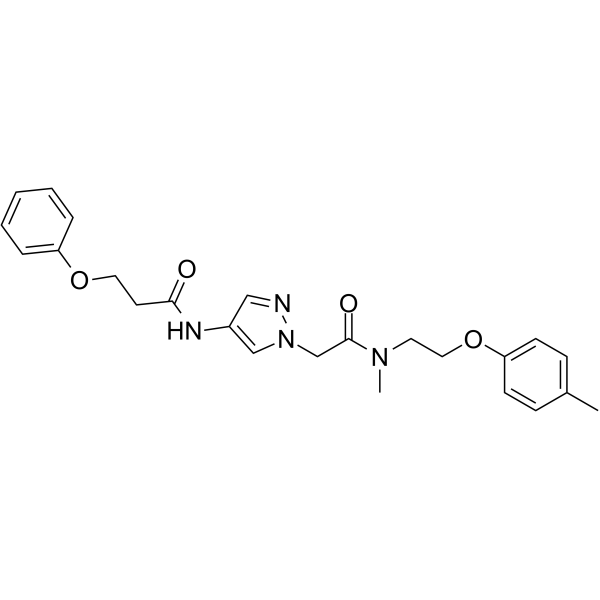|
BP13269
|
ID-8
|
|
|
|
|
ID-8, a DYRK inhibitor, sustains embryonic stem cell self-renewal in long-term culture.
|
|
BP13270
|
Ifosfamide
|
|
|
|
|
Ifosfamide alkylates and forms DNA crosslinks, thereby preventing DNA strand separation and DNA replication. Ifosfamide is a synthetic analog of the nitrogen mustard cyclophosphamide with antineoplastic activity. This agent is a prodrug that must be activated through hydroxylation by hepatic microsomal enzymes.
|
|
BP13271
|
IIIM-290
|
|
|
|
|
IIIM-290 is an oral CDK inhibitor (IC50s: 90 and 94 nM for CDK2/A and CDK9/T1).
|
|
BP13272
|
Ilorasertib hydrochloride
|
|
|
|
|
Ilorasertib hydrochloride (ABT-348 hydrochloride) is an ATP-competitive multitargeted kinase inhibitor, which inhibits Aurora C, Aurora B, and Aurora A (IC50s: 1 nM, 7 nM, 120 nM). It also suppresses RET tyrosine kinase, PDGFRβ, and Flt1 (IC50s: 7 nM, 3 nM, and 32 nM).
|
|
BP13273
|
IMP-1088
|
|
|
|
|
IMP-1088 is a potent inhibitor of human N-myristoyltransferases NMT1 and NMT2 dual.
|
|
BP13274
|
IMT1
|
|
|
|
|
IMT1 is a first-in-class specific and noncompetitive human mitochondrial RNA polymerase (POLRMT) inhibitor. IMT1 causes a conformational change of POLRMT, which blocks substrate binding and transcription in a dose-dependent way in vitro. IMT1 reduces deoxynucleoside triphosphate levels and citric acid cycle intermediates, resulting in a marked depletion of cellular amino acid levels. IMT1 has the potential for mitochondrial transcription disorders related diseases.
|
|
BP13275
|
Indirubin-3′-oxime
|
|
|
|
|
Indirubin-3-monoxime is an effective inhibitor of cyclin-dependent protein kinases, and may play an obligate role in neuronal apoptosis in Alzheimer's disease.
|
|
BP13276
|
Indirubin-3'-monoxime
|
|
|
|
|
Indirubin-3'-oxime is a potent inhibitor of GSK3β (IC50: 22 nM) and also inhibits CDKs ( (IC50s: 100/180/250 nM for Cdk5/p35, Cdk1/cyclin B, Cdk2/cyclin E).
|
|
BP13277
|
Indisulam
|
|
|
|
|
Indisulam is a carbonic anhydrase inibitor and Antitumor CDK inhibitor. Indisulam targets the G1 phase of the cell cycle by depleting cyclin E. inducing p53 and p21, and inhibiting CDK2, causing a blockade in the G1/S transition.
|
|
BP13278
|
Indomethacin-D4
|
|
|
|
|
Indomethacin-D4 is a deuterium labeled Indomethacin. Indomethacin is a potent and nonselective inhibitor of COX1 and COX2, with IC50s of 18 nM and 26 nM for human COX-1 and COX-2, respectively, in CHO cells.
|
|
BP13279
|
Indoramin D5
|
|
|
|
|
Indoramin D5 is a piperidine antiadrenergic agent. Indoramin D5 is deuterium labeled Indoramin.
|
|
BP13280
|
IPR-803
|
|
|
|
|
IPR-803 is an effective inhibitor of the uPAR·uPA protein-protein interaction (PPI) with anti-tumor activity. IPR-803 binds directly to uPAR with a Ki of 0.2 μM.
|
|
BP13281
|
IRE1α kinase-IN-1
|
|
|
|
|
IRE1α kinase-IN-1 is a highly selective IRE1α (ERN1) inhibitor, with an IC50 of 77 nM. It displays 100-fold selectivity for IRE1α over the IRE1β isoform. It inhibits ER stress-induced IRE1α oligomerization and autophosphorylation, and also inhibits IRE1α RNase activity (IC50=80 nM)
|
|
BP13282
|
Isoangustone A
|
|
|
|
|
Isoangustone A has antitumor activity, it can induce G1 cycle arrest in DU145 human prostate and 4T1 murine mammary cancer cells, it inhibits cell proliferation by targeting PI3K, MKK4, and MKK7 in human melanoma. Isoangustone A dampens mesangial sclerosis associated with inflammation in response to high glucose through hindering TGF-β and NF-κB signaling. Isoangustone A also shows strong ferric reducing activities and effectively scavenged DPPH, ABTS(+), and singlet oxygen radicals.
|
|
BP13283
|
Isoguanine
|
|
|
|
|
Isoguanine is a purine base that is an isomer of guanine. A building block in organic synthesis.
|
|
BP13284
|
Isoindigotin
|
|
|
|
|
Isoindigotin is used in the therapy of Y.
|
|
BP13285
|
IU1
|
|
|
|
|
IU1(IC50=4.7 μ M), a reversible, specific human USP14 proteasome inhibitor, can penetrate the cell.
|
|
BP13286
|
IU1-248
|
|
|
|
|
IU1-248 is a derivative of IU1. IU1-248 is a potent and selective USP14 inhibitor with an IC50 of 0.83 μM.
|
|
BP13287
|
IU1-47
|
|
|
|
|
IU1-47 is an effective and specific USP14 inhibitor (IC50: 0.6 μM). IU1-47 causes tau elimination in cultured neurons. IU1-47 inhibits IsoT/USP5 (IC50: 20 μM).
|
|
BP13288
|
IXA4
|
|
|
|
|
IXA4 is a highly selective, nontoxic activator of IRE1/XBP1s and reduces APP secretion by activating IRE1. IXA4-stimulated IRE1 activation also enhanced pancreatic function.
|
